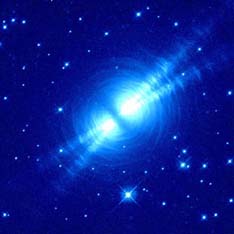|
PREREQUISITE: |
AST 301, 302, 303, or the equivalent (one semester of introductory
college-level astronomy for non-science majors) |
| | |
|
CONTENT AND LEVEL: |
The AST 309 courses are follow-up electives to the introductory astronomy
courses, and provide a choice among various topics. AST 309N focuses on stars and
stellar evolution, including such exotic phenomena as solar neutrinos, brown
dwarfs, planets around other stars, white dwarfs, supernovae, pulsars, and black
holes. We will emphasize the understanding of concepts; mathematics will be
kept to a minimum. This
section of AST 309N satisfies the requirement for a lower division course with a
substantial writing component (SWC). |
| | |
|
TEXTS: |
The textbooks are "100 Billion Suns: The Birth, Life, and Death of the Stars," by Rudolf Kippenhahn and "Prisons of Light: Black Holes," by Kitty Ferguson. I prefer John Gribbin's book "Unveiling the Edge of Time," but it is currently out of stock; my advice is to buy a copy if you see it at a bookstore. All are inexpensive paperbacks, and will be available at the textbook stores. In addition, a set of Instructor's Notes will be kept on 2-hour reserve in the Physics-Math-Astronomy (PMA) library on the ground floor of RLM.
Other useful materials will also be kept on reserve at the PMA library. |
| | |
|
ASSIGNMENTS AND GRADING BASIS: |
The required work and basis for course grade will consist of:
-
three in-class hour exams, each 15% of grade,
tentative dates Oct. 2, Nov. 6, Dec. 2: 45%
-
various writing assignments, including two term papers
(no longer than eight typed pages each): 45%
-
Class participation: 10%
|
| | |
|
REASON FOR THE WRITING COMPONENT: |
Does it surprise you to find an astronomy course with a substantial writing
component? It shouldn't! Good writing means effective communication on paper,
or, these days, in the form of a text file on a computer. The ability to express
one's ideas clearly and succinctly is an important skill for almost any situation
and career. Furthermore, writing about new material forces you to confront what
you do and what you don't understand: it's often been said that you learn
something best when you have to explain it to someone. In this course, we will
use writing assignments as tools to focus our understanding of the material as
well as for the purpose of developing writing skills. |
| | |
|
POLICIES: |
All assignments are expected to be handed in on time. Late papers will suffer
substantial academic penalties, such as down-grading by one letter grade for each
two days of lateness and an automatic "fail" for that assignment after one week.
Guidelines for the presentation of the assignments will be announced and
distributed in advance, and must be followed. For example, term papers must be
typed (or computer-printed), double-spaced, stapled, and on standard-size paper.
Naturally we expect that all submitted papers are your own work. |
| | |
|
NOTE: |
Be sure that you read the handout called "Memo to Undergraduate Astronomy
Students Regarding Astronomy Courses," which gives information on general
departmental policies and useful telephone numbers. As mentioned in that
handout, your instructor is a working professional who must occasionally go out
of town in order to attend meetings or use telescopes. On these dates, another
astronomy faculty member will give a lecture or lead a special class activity. |
| | |
|
TOPICS: |
The following is a list of topics that I plan to cover:
-
introduction and review: what makes the stars shine?
-
the "Main Sequence" stars, from supermassive stars to brown dwarfs
-
brown dwarfs and "extrasolar" planets
-
star formation: in darkness born
-
the "mid-life" crisis: becoming a red giant
-
last days of a low-mass star: planetary nebulae and white dwarfs
-
finale for a massive star: the supernova smash-up, pulsars
-
the intrigues of interacting stars, Part 1: effects of mass transfer
-
general relativity, a new theory of gravity: warped space-time
-
the nature of black holes
-
interacting stars, part 2: real live black holes in binary systems
|

